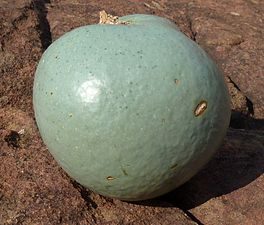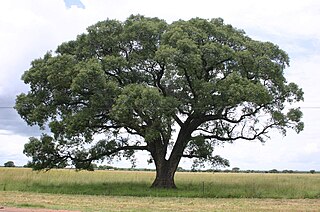
Sclerocarya birrea, commonly known as the marula, is a medium-sized deciduous fruit, indigenous to the miombo woodlands of Southern Africa, the Sudano-Sahelian range of West Africa, the savanna woodlands of East Africa and Madagascar.

Dovyalis caffra (Warb.), Aberia caffra the Umkokola, Kei apple, Kayaba, Kai apple, or Kau apple, is a small to medium-sized tree, native to southern Africa. Its distribution extends from the Kei River in the south, from which the common name derives, northwards along the eastern side of the continent to Tanzania. The ripe fruits are tasty, reminiscent of a small apple.
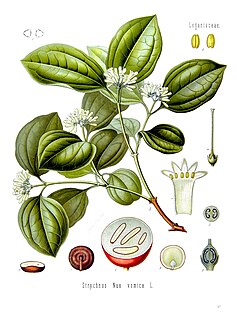
Strychnos nux-vomica, the strychnine tree, also known as nux vomica, poison fruit, semen strychnos, and quaker buttons, is a deciduous tree native to India and to southeast Asia. It is a medium-sized tree in the family Loganiaceae that grows in open habitats. Its leaves are ovate and 2–3.5 inches (5.1–8.9 cm) in size. It is known for being the natural source of the extremely poisonous compound strychnine.

Cucumis metuliferus, commonly called the African horned cucumber, horned melon, spiked melon, jelly melon, kiwano, or cuke-a-saurus is an annual vine in the cucumber and melon family, Cucurbitaceae. Its fruit has horn-like spines, hence the name "horned melon". The ripe fruit has orange skin and lime green, jelly-like flesh. C. metuliferus is native to Southern Africa. It is found in South Africa, Namibia, Botswana, Zambia, Zimbabwe, Mozambique, and Angola.

Strychnos is a genus of flowering plants, belonging to the family Loganiaceae. The genus includes about 100 accepted species of trees and lianas, and more than 200 that are as yet unresolved. The genus is widely distributed around the world's tropics and is noted for the presence of poisonous indole alkaloids in the roots, stems and leaves of various species. Among these alkaloids are the well-known and virulent poisons strychnine and curare.

Solanum quitoense, known as naranjilla in Ecuador, Costa Rica, and Panama and as lulo in Colombia, is a tropical perennial plant from northwestern South America. The specific name for this species of nightshade means "from Quito."

Ziziphus mauritiana, also known as Indian jujube, Indian plum, Chinese date, Chinese apple, and dunks is a tropical fruit tree species belonging to the family Rhamnaceae. It is often confused with the closely related Chinese jujube, but whereas Z. jujuba prefers temperate climates, Z. mauritiana is tropical to subtropical.

Aegle marmelos, commonly known as bael, also Bengal quince, golden apple, Japanese bitter orange, stone apple or wood apple, is a rare species of tree native to the Indian subcontinent and Southeast Asia. It is present in India, Bangladesh, Sri Lanka, and Nepal as a naturalized species. The tree is considered to be sacred by Hindus.

Searsia pyroides, previously known as Rhus pyroides, is a species of Searsia, native to southern Africa. This tree occurs throughout the whole of South Africa, a part of Botswana, Zimbabwe and Tanzania and in some areas of Namibia near Windhoek.
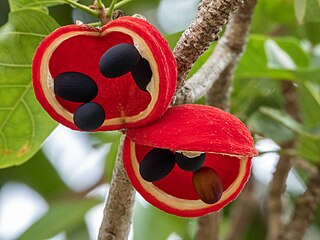
Sterculia quadrifida, also known as the peanut tree, or red-fruited kurrajong is a small tree that grows in the rainforests, vine thickets, and gallery forests of New Guinea and northern Australia.
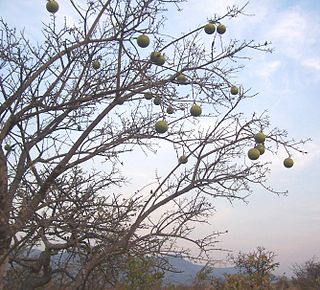
Strychnos spinosa, the Natal orange, is a tree indigenous to tropical and subtropical Africa. It produces sweet-sour, yellow fruits, containing numerous hard brown seeds. Greenish-white flowers grow in dense heads at the ends of branches. The fruits tend to appear only after good rains. It is related to the deadly Strychnos nux-vomica, which contains strychnine. The smooth, hard fruit are large and green, ripen to yellow colour. Inside the fruit are tightly packed seeds, which may be toxic, surrounded by a fleshy, brown, edible covering. Animals such as baboon, monkeys, bushpig, nyala and eland eat the fruit. The leaves are a popular food source for browsers such as duiker, kudu, impala, steenbok, nyala and elephant.

Acanthosicyos naudinianus, known as the Gemsbok cucumber, is a perennial African melon with edible fruits and seeds.

Uapaca kirkiana, the sugar plum or mahobohobo, is a species of dioecious plant in the family Phyllanthaceae. It is native to the southern Afrotropics, where it occurs in well-watered miombo woodlands. Within range it is one of the most popular wild fruits. It is rarely cultivated but trees are left when land is being cleared. Still a traditional food plant in Africa, this little-known fruit has the potential to improve nutrition, boost food security, foster rural development and support sustainable land care.

Ehretia rigida, is a small, multi-stemmed tree with a tangled growth habit belonging to the Boraginaceae, the borage family. It occurs over a wide range of habitat throughout the eastern part of South Africa, and in Namibia, Botswana, Zimbabwe and Mozambique.

Capparis tomentosa, the woolly caper bush or African caper, is a plant in the Capparaceae family and is native to Africa.
Commiphora africana, commonly called African myrrh, is a small deciduous tree belonging to the Burseraceae, a family akin to the Anacardiaceae, occurring widely over sub-Saharan Africa in Angola, Botswana, Burkina Faso, Chad, Eswatini, Eritrea, Ethiopia, Kenya, Mali, Mauritania, Mozambique, Namibia, Niger, Senegal, Somalia, South Africa, Sudan, Tanzania, Uganda, Zambia and Zimbabwe. On sandy soils this species sometimes forms pure stands, deserving consideration as a plant community or association.

Viscum combreticola, the Combretum mistletoe, is a leafless, dioecious mistletoe shrub, occurring from southern to tropical Africa, in a broad zone following the Rift Valleys. Though it is typically a hemiparasite of Combretum species, it may also be found on Terminalia (Combretaceae), Acacia, Croton, Diplorhynchus, Dombeya, Heteropyxis, Maytenus, Melia, Strychnos or Vangueria.

Strychnos madagascariensis, the black monkey orange, is an African tropical and sub-tropical tree belonging to the Loganiaceae family. It is a tree with characteristically large fruit but can confused with some other species of the genus.

Ximenia caffra, the sourplum, is a small tree or small shrub that is thinly branched. It is part of the Olacaceae family which is native throughout tropical regions. In particular, the sourplum is native to regions in South East Africa, mainly Botswana, Kenya, Malawi, Mozambique, South Africa, Tanzania, Uganda, Zambia, and Zimbabwe. The sourplum tree produces several fruits on an annual basis. These are generally sour with a dry aftertaste, and they contain significant amounts of potassium. The tree itself is fairly hardy, with frost resistance and drought tolerance. The tree, fruit, seed, leaves, and roots are all used for human consumption, medicinally, or for fuel. The trees themselves can also be used as natural land division barriers.

Asparagus retrofractus is a shrub of the Asparagus genus that is indigenous to the western regions of South Africa.




